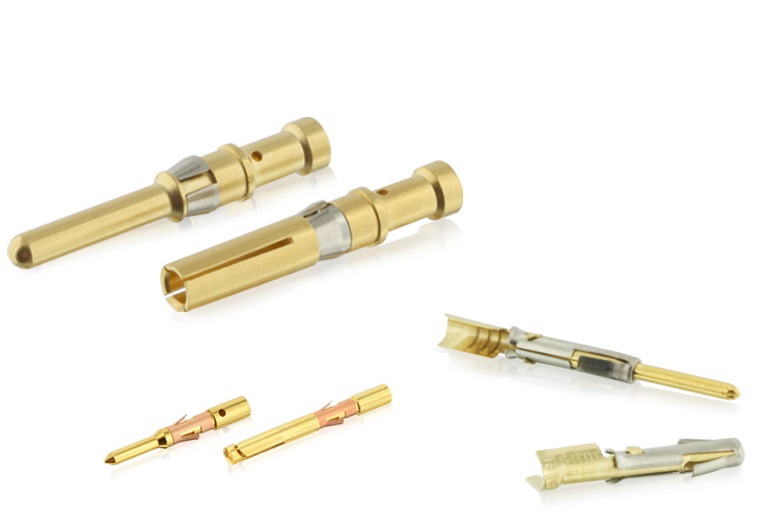Choosing Contacts: Solder vs Crimp?
Choosing the right contacts is not always easy, especially if you do not have engineers specialized in interconnect designs. The quick answer to the question is: neither. One will be more suitable in some cases, while in other cases it will not. This guide explains the key factors to consider when deciding which solution will be most suitable for your design.
SCENARIO 1: When you don’t have a choice
Probably the easiest case, in many situations you won’t need to choose because the choice will be imposed. This relates to aerospace and defense standards where most of the time contacts need to be crimped.

Crimp contacts can be machined or stamped and formed
Examples:
MIL-DTL-38999: This military standard indicates right in the title that the connectors must have removable crimp contacts (except hermetic contacts which are soldered).
DETAIL SPECIFICATION CONNECTORS, ELECTRICAL, CIRCULAR, MINIATURE, HIGH DENSITY, QUICK DISCONNECT (BAYONET, THREADED, AND BREECH COUPLING), ENVIRONMENT RESISTANT, REMOVABLE CRIMP AND HERMETIC SOLDER CONTACTS, GENERAL SPECIFICATION FOR
MIL-DTL-26482: This standard covers two different versions: series 1 and series 2. Both break down into a variety of specifications that dictate whether the contact type should be solder or crimp.
Series 1, solder: MS3110, MS3111, MS3112, MS3113, MS3114, MS3116, MS3119
Series 1, crimp: MS3120, MS3121, MS3122, MS3124, MS3126, MS3127, MS3128
Series 2, solder: MS3440, MS3442, MS3443, MS3449
Series 2, crimp: MS3470, MS3471, MS3472, MS3473, MS3474, MS3475, MS34776, MS3477, MS3479
(source: EverySpec.com)
Note: In the case of hermetic connectors, solder contacts are the standard since the contacts are non-removable (encased in glass).
Standards may often determine what type of contact you need, and it is likely that if you are in that situation, you already know what contacts and connectors you need. They are prevalent in aerospace and defense, but also railway and for certain machine tools.
SCENARIO 2: When you do have a choice

Solder contacts have little solder buckets at the back. They are usually preloaded in the connectors
Here is where it gets more interesting; if you do have a choice, that means you will need to pick the type of contact termination that is most suitable for your application. Our technical support team compares different advantages and disadvantages for both options, as well as screw terminal connectors which are available for certain product ranges.
|
|
ADVANTAGES |
DISADVANTAGES |
|---|---|---|
|
Solder |
Minimal specific tooling required (soldering iron) Can terminate contacts that are already mounted in the connector Decent resistance to vibration |
Process generates heat in the contacts, the connector and even in the cable which can potentially cause problems (if the temperature rises above the operational limits of the insert). More sensitive to corrosion (adding another metal) Mechanically more sensitive to vibration and flexing (more fragile) Multiple quality problems may arise from the soldering quality (ex : cold solder) Requires a RoHS compliant solder (most solders contain lead which is banned by RoHS)
|
|
Crimp |
High resistance to vibration Crimping process is simple, fast and repeatable Can be manual or automatic (fed into a crimping machine) |
Requires tooling that is specific to the contacts The barrel and the cable must match – in size and in constitution (monofilament or multi conductor). |
|
Screw Termination |
Assembly and termination do not require any specific tools Can be assembled and taken apart to modify or repair the cables and components. |
Not suitable for high vibration and shock environments. The barrel and the cable must match – in size and in constitution (monofilament or multi conductor). |
Crimping is usually preferred for its high reliability especially in harsh environments. Soldered contacts will be more vulnerable to corrosion, and will be less flexible when it comes to vibration and flexing. Crimping can also be automated in a very fast and efficient way if one has crimping machines into which the contacts are fed, or even if it is done manually. However, the setup is costly and makes sense for large volumes.
For harsh applications requiring smaller volumes (and hermetic receptacles), soldering offers a more flexible approach, although it is less convenient to industrialize the process.
Finally, screw termination is your best option if you require installation on the field. It is a less mechanically robust option, but for some applications where there is not a requirement, this solution is convenient and flexible.
Hopefully this guide will help you choose which contact termination type is best for you. If you have any further questions, please feel free to contact our technical support team and we’ll get back to you as soon as possible.
Recommended reading:
How to choose the right contacts for your connector?
More information
Discover SOURIAU's product offer for contacts
